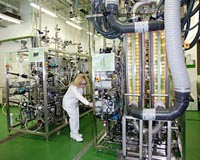 |
Paris, France (ESA) Jun 22, 2009 On 14 July, a crew of six will leave their Mars mission simulator and see the Sun once again. The crew, which includes a French pilot and a German engineer selected by the European Space Agency, will have completed 105 days of confinement and numerous scientific experiment runs inside the isolation facility at the Russian Institute for Biomedical Problems (IBMP) in Moscow. Their simulated mission will help understand the psychological and medical aspects of long-duration spaceflight. Media representatives are invited to meet the crew just after they have opened the door and stepped out of the isolation facility. There will be opportunities for the media to film and take photos of the facility, interview the six participants and project management and meet the Russian and European space authorities, including ESA's Director of Human Spaceflight Simonetta Di Pippo. A detailed programme will be published at the beginning of July. The crew includes two European members selected by ESA: Oliver Knickel, a mechanical engineer in the German army, and Cyrille Fournier, an airline pilot from France. The remaining four are Russians: cosmonauts Sergei Ryazansky (commander) and Oleg Artemyez, Alexei Baranov, a medical doctor, and Alexei Shpakov, a sports physiologist. They have been living in the specially designed isolation facility in Moscow since 31 March. Inside, they have been put through a range of scenarios as if they really were travelling to the Red Planet-including launch, the outward journey, arrival, transfer to and from the Martian surface and finally the long journey home. Their tasks have been similar to those they would have on a real space mission. They have had to deal with simulated emergencies and cope with an operative communication delay of up to 20 minutes each way. The participants have been subjected to scientific experiments to assess the effects of isolation on various psychological and physiological parameters. The experiments conducted were proposed by research institutes in countries throughout Europe, including Germany, France, Italy, Belgium, Austria and the Netherlands, as well as in Russia and the United States. This initial 105-day study is the precursor to a complete simulation of a fully-fledged mission to Mars and back due to start in early 2010. That exercise will see another six-member crew sealed in the same chamber to experience a complete 520-day Mars mission. Both studies are part of the Mars500 programme that is being conducted by ESA and its Russian partner IBMP. ESA's Directorate of Human Spaceflight is undertaking Mars500 as part of its European Programme for Life and Physical Sciences (ELIPS) to prepare for future missions to the Moon and Mars. Share This Article With Planet Earth
Related Links Mars500 programme Mars News and Information at MarsDaily.com Lunar Dreams and more
 Life Support Pilot Plant Paves The Way To Moon And Beyond
Life Support Pilot Plant Paves The Way To Moon And BeyondParis, France (ESA) Jun 08, 2009 A pilot plant inaugurated in Barcelona, Spain, is testing regenerative life support system technologies that could one day recycle waste products and supply essential food, water and oxygen to humans living on the surface of the Moon or Mars. MELiSSA, short for Micro-Ecological Life Support System Alternative, is an artificial ecosystem to recover food, water and oxygen from ... read more |
|
| The content herein, unless otherwise known to be public domain, are Copyright 1995-2009 - SpaceDaily. AFP and UPI Wire Stories are copyright Agence France-Presse and United Press International. ESA Portal Reports are copyright European Space Agency. All NASA sourced material is public domain. Additional copyrights may apply in whole or part to other bona fide parties. Advertising does not imply endorsement,agreement or approval of any opinions, statements or information provided by SpaceDaily on any Web page published or hosted by SpaceDaily. Privacy Statement |